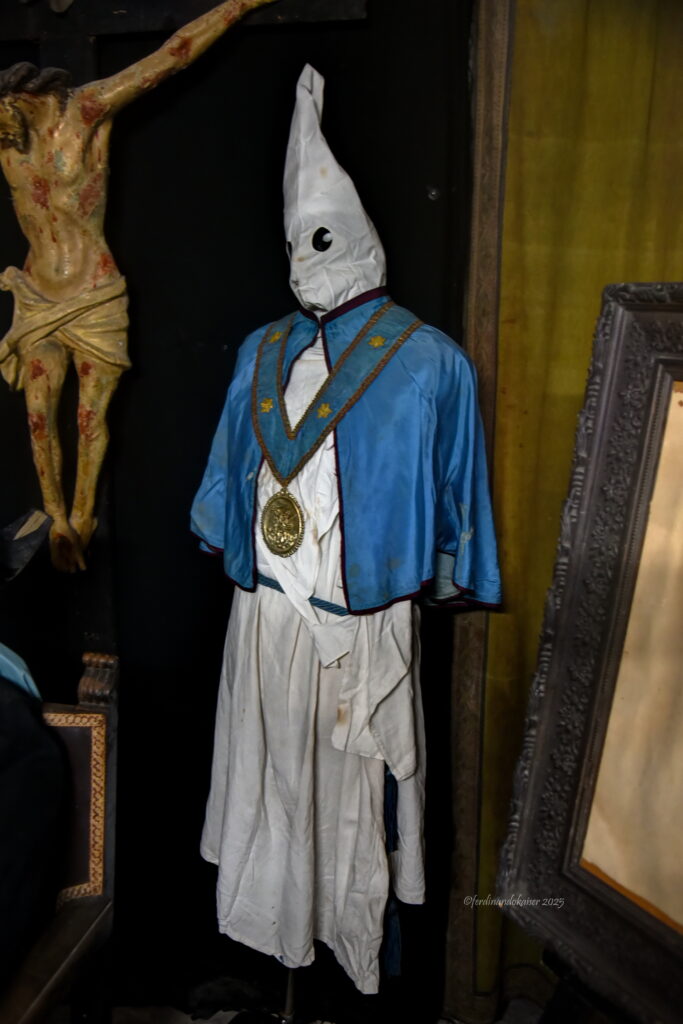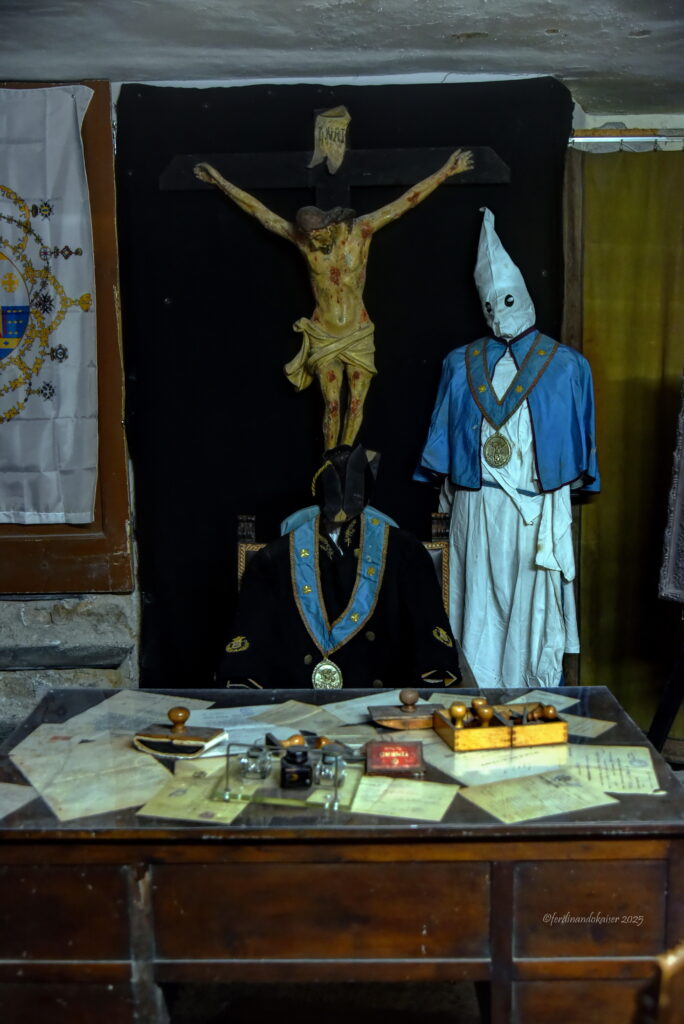Per Confraternita si intende, un’associazione pubblica di fedeli della Chiesa Cattolica che ha come scopo peculiare e caratterizzante l’incremento del culto pubblico, l’esercizio di opere di carità, di penitenza, di catechesi non disgiunta dalla cultura. Costituite canonicamente con formale decreto dell’Autorità ecclesiastica cui viene demandata la facoltà di modificarle o di sopprimerle, hanno uno statuto, un titolo, un nome e vestono una sorta di divisa particolare. I loro componenti conservano lo stato laico e restano nella vita secolare, pertanto non hanno obblighi di prestare voti o di fare vita in comune così come non devono fornire il proprio patrimonio e la propria attività alla confraternita. All’origine incerta delle confraternite non mancano le supposizioni che le vedono collegate ad istituzioni d’epoca pre-cristiana, ai collegia romani o alle fraterie greche e della Magna Grecia.
Vestiario confraternite
Semplicità e immediato riconoscimento sono le caratteristiche che contraddistinguono il vestiario delle confraternite, seguendo la filosofia della loro attività cristiana. Sulla base del motto pace e misericordia, su cui si fonda il movimento che in Italia si diffuse ampiamente a partire dal Medio Evo, ancora oggi le confraternite svolgono la loro importante opera con azioni caritatevoli, che vanno a sostegno dei più bisognosi, insieme alla diffusione del culto cristiano e di catechesi.
Come la maggior parte delle associazioni pubbliche anche le confraternite hanno adottato, fin dalla loro nascita, una particolare divisa. La necessità era quella di creare un abito che potesse rendere i membri del sodalizio immediatamente riconoscibili agli altri. Essendo nata come forma associativa di riparazione per i peccati del mondo, inizialmente l’abbigliamento dei confratelli era ispirato alla vita monastica. Era costituito perciò da rozze tuniche di iuta, la stoffa più povera dell’epoca. Non a caso l’abito veniva principalmente denominato sacco. Tale abbigliamento divenne, come lo è tutt’ora, uno dei simboli che più di ogni altro identifica l’appartenenza al sodalizio, distinguendo un’associazione dall’altra. L’abbigliamento di un tempo aveva, però, anche un uso di tutela per i confratelli che si trovavano spesso ad operare con appestati e malati di ogni genere negli Ospedali e nei Sanatori o nella cura dei Morti. Ecco, allora, i grandi cappucci calati davanti al viso, per proteggersi dal possibile contagio.
Caratteristiche principali del vestiario delle confraternite
La cappa è la parte dell’abbigliamento che più contraddistingue l’appartenenza ad una confraternita; è un abito benedetto e viene consegnato ufficialmente durante il rito della vestizione. La cappa, chiamata anche mozzetta o mantellina per le sue ridotte dimensioni rispetto alla classica mantella che copriva il semplice abito dei confratelli, è generalmente realizzata in raso (in questo abito è azzurra perché l’azzurro è il colore del cielo e prefigura la Gloria Eterna) ed è rifinita lungo tutti i bordi con un tessuto sbieco generalmente in oro o argento. Può avere o meno un piccolo collo ed è aperta sul davanti. E’, inoltre, provvista di un piccolo gancio cucito sul petto, che serve per appendere il medaglione che diversifica ogni confraternita. I medaglioni, infatti, sono segni rappresentativi del mondo cattolico e portano raffigurati le immagini di un santo o di una rilevante figura cristiana, come qui, ad esempio, San Michele Arcangelo, che è l’emblema del culto cui la confraternita è legato. Ogni confraternita difatti sceglie, prima ancora di iniziare la sua attività, a quale figura cristiana riferirsi nello svolgimento della sua opera. Di forma pressoché ovale, il medaglione, può essere realizzato in vari materiali. L’abbigliamento si completa con un abito molto semplice, una sorta di camicione lungo fino ai piedi, bianco o color avorio, che si indossa sotto alla mantellina. Oltre al colore della mantellina, che varia in base all’associazione, un motivo di ulteriore riconoscimento è il cingolo. Si tratta di vere e proprie cinture costituite da cordoni intrecciati che, il più delle volte, portano delle grandi nappe appese alle due estremità. Il colore scelto per questi cingoli è un ulteriore elemento valido ad illustrare le motivazioni che ispirano l’azione dei membri. Hanno anche un significato culturale e storico.
The “hooded” of the Archconfraternity of San Michele Arcangelo in Pistasi.
By Confraternity we mean a public association of believers of the Catholic Church whose peculiar and characterizing purpose is the increase of public worship, the exercise of works of charity, penance, catechesis not separated from culture. Canonically constituted with a formal decree of the ecclesiastical Authority which is entrusted with the power to modify or suppress them, they have a statute, a title, a name and wear a sort of particular uniform. Their members retain the lay state and remain in secular life, therefore they have no obligation to take vows or to live in community just as they do not have to provide their assets and their activity to the confraternity. The uncertain origin of the confraternities is not lacking in suppositions that see them connected to institutions of the pre-Christian era, to the Roman collegia or to the Greek and Magna Graecia fraternities.
Confraternity clothing
Simplicity and immediate recognition are the characteristics that distinguish the clothing of the confraternities, following the philosophy of their Christian activity. Based on the motto peace and mercy, on which the movement that spread widely in Italy starting from the Middle Ages is based, even today the confraternities carry out their important work with charitable actions, which go to support the most needy, together with the diffusion of the Christian cult and catechesis.
Like most public associations, the confraternities have also adopted, since their birth, a particular uniform. The need was to create a dress that could make the members of the association immediately recognizable to others. Having been born as an associative form of reparation for the sins of the world, the clothing of the brothers was initially inspired by monastic life. It was therefore made up of rough jute tunics, the poorest fabric of the time. It is no coincidence that the dress was mainly called sack. This clothing became, as it still is, one of the symbols that more than any other identifies membership in the brotherhood, distinguishing one association from another. However, the clothing of the past also had a protective use for the brothers who often found themselves working with plague victims and sick people of all kinds in hospitals and sanatoriums or in the care of the dead. Here, then, are the large hoods pulled down in front of the face, to protect themselves from possible contagion.
Main characteristics of the clothing of the brotherhoods
The hood is the part of the clothing that most distinguishes membership in a brotherhood; it is a blessed garment and is officially delivered during the dressing rite. The cappa, also called mozzetta or mantellina for its smaller size compared to the classic cape that covered the simple habit of the brothers, is generally made of satin (in this habit it is blue because blue is the color of the sky and prefigures Eternal Glory) and is finished along all the edges with a bias fabric generally in gold or silver. It may or may not have a small collar and is open at the front. It is also provided with a small hook sewn on the chest, which is used to hang the medallion that differentiates each brotherhood. The medallions, in fact, are representative signs of the Catholic world and bear the images of a saint or a significant Christian figure, as here, for example, Saint Michael the Archangel, who is the emblem of the cult to which the brotherhood is linked. In fact, each brotherhood chooses, even before starting its activity, which Christian figure to refer to in carrying out its work. Almost oval in shape, the medallion can be made of various materials. The clothing is completed with a very simple dress, a sort of floor-length shirt, white or ivory colored, which is worn under the cape. In addition to the color of the cape, which varies according to the association, a further reason for recognition is the cincture. These are real belts made of intertwined cords that, most of the time, have large tassels hanging from the two ends. The color chosen for these cinctures is a further valid element to illustrate the motivations that inspire the action of the members. They also have a cultural and historical meaning.




